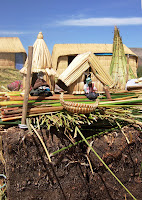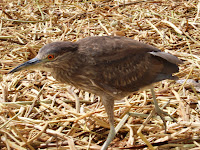
Once again on Lake Titicaca... we thank Enrique of Mystery Peru for this Island Excursion..
Anyways, we were lucky to have good weather as you can see in the photos. Les iles d'Uros ou les iles flottantes du Lac Titicaca... faites seulement de roseaux! Merci a notre ami de Nasca, Enrique qui nous a offert cette excursion pour me remercier de la traduction de son site Internet, www.mysteryperu.com


So we started from Puno and took a boat to this floating island that is made of REEDS... only REEDS... It is really floating in the middle of a Lake that is at 3850mtrs in Altitude... Amazing don´t you think? Depart de Puno dans un jolie bateau avec interieur bois (vaut mieux car on y passera bcp d'heures dans ce bateau...)

We went on a tour group.. It´s really a tourist thing to do. Very well presented and well explained on how it´s built. Ces iles flottent vraiment sur le Lac Titicaca a plus de 3850m d'altitude!
 Being welcomed by brightly coloured dressed women. Feels like a superstar.. hahahaha... It was nice to see them in their traditional attire.. from head to toe.. although they were basically barefooted here. It´s like walking on carpet.. Very bouncy effect due to the materials used to build this island.. REEDS..Accueil chaleureux (des sousous potentiels ces touristes!)..Bcp de couleurs et es qu'on sort de notre embarcation, on est surpris par le revetement! On a l'impression de marcher sur n bon gros matelas de gym! C tres agreable...
Being welcomed by brightly coloured dressed women. Feels like a superstar.. hahahaha... It was nice to see them in their traditional attire.. from head to toe.. although they were basically barefooted here. It´s like walking on carpet.. Very bouncy effect due to the materials used to build this island.. REEDS..Accueil chaleureux (des sousous potentiels ces touristes!)..Bcp de couleurs et es qu'on sort de notre embarcation, on est surpris par le revetement! On a l'impression de marcher sur n bon gros matelas de gym! C tres agreable...Savez-vous pourquoi ces gens se sont installes sur ces iles?
Tout d'abord, c'etait pour se proteger et fuir les attaques des tribus ennemis puis des espagnols! En effet, sur ces iles, les gens sont de langues AYMARA, alors que la plupart des autres tribus des environs sont de langue QUECHUA! Ils se sont donc fabriquer leurs propres iles il y a 500ans environs pour sauver leurs vie!
LES ETAPES POUR CONSTRUIRE CES ILES:
So first they somehow cut the roots of the reeds.. which look like a piece of land soil... it´s
D'abord, ils vont sous l'eau ( 10degres), coupent la racine des roseaux, des gros blocs de bonne terre qu'ils lient ensemble afin des cordes afin de constituer la base de 'ile.


This island last for a few years until the base starts to rot, they build a new island. 
 Bateau moderne en forme de Puma (animal mythique du Lac Titicaca et de la culture inca)
Bateau moderne en forme de Puma (animal mythique du Lac Titicaca et de la culture inca)

Apparently, part of the reeds are also edible. VERY USEFUL REED et parait meme que certaines parties se mangent...mais pour nous il ne vaut mieux pas essayer car parait-il que les eaux autour des iles sont tres polluees pour 2 raisons, proximite de la Terre (40min de bateau lent) et car sur les iles d'Uros, pas de systeme d'egout et traitement des dechets + eau peu profonde.

Potatoes, Corns, Beans, Rice.. etc... 
They are friends.. they don´t attack each other.. (quelques animaux domestiques sur l'ile)
So there you go.. UROS ISLAND... NEXT destination.. AMANTANI Island where we will stay a night with a local family. Voila pour les iles flottantes d'UROS...Il covient d'ajouter que maintenant, peu de famille vivent sur ces iles car trop difficile et trop humide (attention les rhumatismes). Il y a maintenant un espece de village en tole et ces iles servent de musees ou les gens viennent travailler et surtout vendre leurs artisanat!!!...Desormais, nous partons en direction des iles AMANTANI ou nous passerons la nuit chez l'habitant...



1 comment:
Voila un bien joli reportage ! Mais la version sous-titrée n'est pas arrivée jusqu'en France ! Pense à ta pauvre mère :D et à Tonton Jean-Luc ;-)
Post a Comment